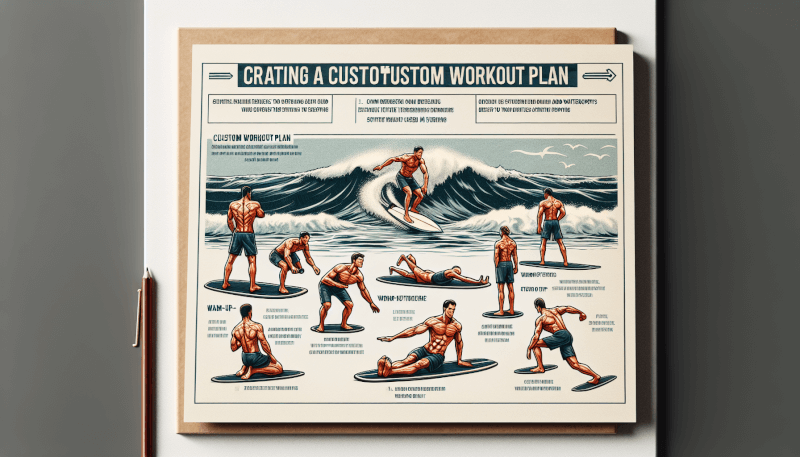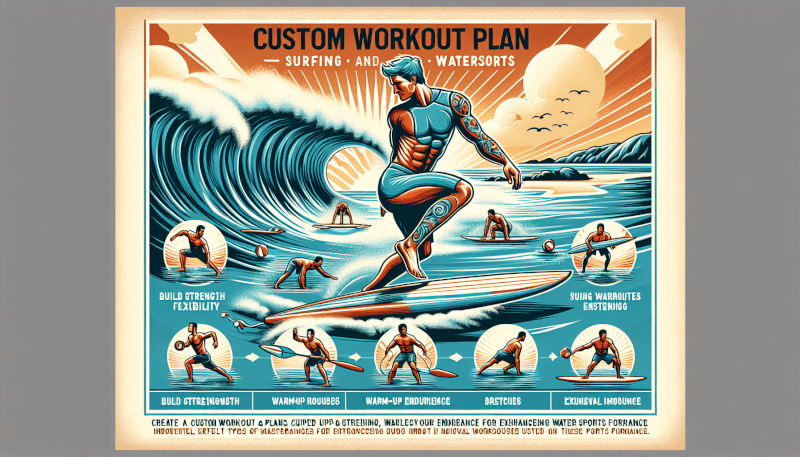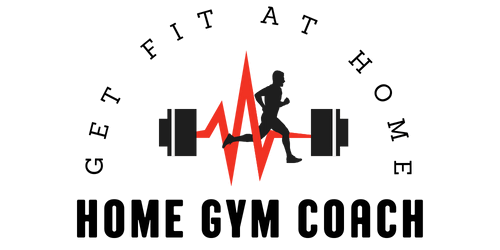Are you ready to take your surfing and watersports skills to the next level? Look no further! With our custom workout plans, specifically designed for surfers and watersports enthusiasts like you, you can enhance your strength, endurance, and flexibility, giving you the edge you need out on the waves. Whether you’re a beginner just getting started or an experienced athlete looking to improve your performance, our personalized workouts will help you reach your goals and conquer the ocean like never before. Get ready to ride the waves with confidence and style – let’s dive into the world of custom workout plans for surfing and watersports!

Benefits of Custom Workout Plans for Surfing and Watersports
Surfing and other watersports require a unique set of physical abilities and skills. To enhance your performance and reduce the risk of injury, it is crucial to follow a custom workout plan tailored specifically for these activities. Here are some key benefits of incorporating a customized workout routine into your surfing and watersports training regimen.
Improved Performance
A custom workout plan can significantly enhance your performance in the water. It focuses on improving the specific physical abilities required for surfing and watersports, such as balance, strength, power, and endurance. By targeting these areas, you can paddle faster, catch more waves, and execute maneuvers with better precision and control.
Reduced Risk of Injury
Participating in activities like surfing and watersports exposes your body to various risks and potential injuries. However, with an adequately designed workout plan, you can minimize these risks. In addition to improving your overall fitness, a customized routine will address the specific demands of these sports, strengthening your muscles and joints and enhancing your body’s ability to withstand the physical stresses associated with riding waves and engaging in water-based activities.
Increased Endurance
Building endurance is crucial for surfers and watersports enthusiasts. These activities require prolonged periods of physical exertion, and a lack of endurance can lead to fatigue, reduced performance, and even injuries. A custom workout plan will include cardio exercises and endurance training that specifically target the muscles and energy systems used during surfing and watersports, allowing you to paddle longer, ride more waves, and enjoy your time in the water without feeling exhausted.
Enhanced Balance and Stability
Maintaining balance and stability is essential when participating in surfing or other watersports. Wobbly movements or lack of stability can compromise your performance and increase the likelihood of falls or injuries. A customized workout routine will incorporate balance and stability exercises, developing your core strength and improving your body’s ability to maintain stability on a board. These exercises can help you stay better balanced on your surfboard, make quick adjustments, and stay in control even in challenging conditions.
Understanding the Demands of Surfing and Watersports
Before diving into a custom workout plan, it is essential to understand the specific physical demands associated with surfing and watersports. By familiarizing yourself with these requirements, you can develop a targeted training program that caters to your unique needs. Here are the key aspects you need to focus on when designing your workout routine.
Functional Movements
Surfing and watersports involve a variety of functional movements that mimic actions performed in the water. These movements include paddling, popping up onto the board, balancing, and executing maneuvers. A custom workout plan will include exercises that replicate these movements, helping your body become more efficient and proficient in performing them.
Core Strength
Building a strong core is vital for surfers and watersports enthusiasts. Your core muscles play a significant role in maintaining balance, stability, and power during these activities. A customized workout routine will emphasize core-strengthening exercises like planks, Russian twists, and medicine ball throws to improve your core strength and enhance your overall performance on the water.
Power and Explosiveness
Surfing and watersports require bursts of power and explosive movements, such as generating speed for catching waves or executing maneuvers with agility. Your workout plan should include exercises that target power and explosiveness, such as plyometric training, medicine ball slams, and box jumps. By incorporating these exercises, you can improve your ability to generate power quickly and perform explosive movements with ease.
Flexibility and Mobility
Flexibility and mobility are essential for surfers and watersports enthusiasts. Being able to move freely and with a full range of motion allows you to execute maneuvers more effectively and reduce the risk of muscle strains or joint injuries. A customized workout routine will include dynamic stretching exercises, foam rolling, and mobility drills to improve your flexibility, mobility, and overall joint health.

Consulting with a Fitness Professional
Designing an effective custom workout plan can be challenging, especially if you are not familiar with exercise programming or the specific physical demands of surfing and watersports. That’s where consulting with a fitness professional can make all the difference. An experienced fitness expert can assess your current fitness level, help you set goals and objectives, and tailor a workout plan that suits your individual needs and abilities.
Assessment of Current Fitness Level
Before creating a workout plan, a fitness professional will evaluate your current fitness level. This assessment may include tests and measurements to determine your strength, endurance, flexibility, and overall physical condition. By understanding your starting point, the fitness professional can create a customized plan that challenges you appropriately without pushing you beyond your limits.
Setting Goals and Objectives
During your consultation, a fitness professional will help you set realistic and attainable goals related to your surfing and watersports performance. Whether you want to catch more waves, improve your speed, or increase your endurance, setting specific goals will give your training purpose and provide a clear direction for your workout plan. The fitness professional can guide you in setting SMART (Specific, Measurable, Attainable, Relevant, Time-bound) goals that align with your aspirations.
Tailoring a Workout Plan
With your goals and objectives in mind, a fitness professional will tailor a workout plan to improve your surfing and watersports performance effectively. This customized plan will take into account your current fitness level, available equipment or facilities, training preferences, and any existing injuries or limitations. The fitness professional will design a program that incorporates a variety of exercises targeting key areas, such as strength, cardiovascular conditioning, balance, stability, and flexibility.
Components of a Custom Workout Plan
A comprehensive custom workout plan for surfing and watersports typically consists of several key components. Each component plays a vital role in developing the physical attributes necessary for optimal performance in these activities. Here are the main components you can expect to find in a customized workout plan.
Warm-Up and Mobility Exercises
Before diving into the main workout, it is essential to prepare your body with a proper warm-up routine. This warm-up should include dynamic stretching exercises that target the muscles and joints used during surfing and watersports. Additionally, incorporating foam rolling and activation exercises can help improve your mobility and activate specific muscles, ensuring they are firing properly during your training.
Strength Training
Strength training is a fundamental component of any workout plan, and it is particularly crucial for surfers and watersports enthusiasts. A customized strength training routine will include compound exercises that work multiple muscle groups simultaneously, simulating the demands of these activities. Exercises like squats, lunges, deadlifts, push-ups, rows, and pull-ups will help you build overall body strength and functional movement patterns necessary for surfing and watersports.
Cardiovascular Conditioning
To enhance your endurance and cardiovascular fitness, a custom workout plan will incorporate cardiovascular conditioning exercises. This component aims to improve your stamina, allowing you to sustain physical exertion for longer periods. Interval training, alternating between high-intensity bursts and active recovery periods, is a highly effective method for improving cardiovascular fitness. Outdoor cardio options, such as running or cycling, can be integrated into your routine, or you can choose water-specific training activities like swimming or paddleboarding.
Balance and Stability Work
Balance and stability are critical for maintaining control and performing maneuvers on a surfboard or during other watersports. A customized workout plan will include various balance exercises, such as single-leg stands, Bosu ball exercises, or yoga poses, to challenge your body’s ability to maintain stability. Additionally, proprioception drills, which improve your body’s awareness and ability to respond to changes in position, can be incorporated. Training specific to board sports, such as balancing on a balance board or practicing movements on a wobble board, will further enhance your stability and balance skills.
Flexibility and Stretching
Flexibility and stretching exercises are essential for preventing injuries, maintaining optimal joint health, and improving overall mobility. A custom workout plan will include static stretches that target the muscles used during surfing and watersports. Yoga and Pilates can also be incorporated, as these practices enhance flexibility, core strength, and body awareness. Additionally, foam rolling exercises can be included in your routine to aid in muscle recovery and relieve any muscle tightness or soreness.

Warm-Up and Mobility Exercises
A solid warm-up routine prepares your body for the upcoming workout and helps reduce the risk of injuries. A custom workout plan for surfing and watersports will include specific warm-up and mobility exercises that focus on the muscles and joints used during these activities.
Dynamic Stretching
Dynamic stretching involves moving your body through a full range of motion, unlike static stretching, where you hold a stretch for an extended period. Dynamic stretches activate the muscles and increase blood flow to the target areas, improving flexibility and range of motion. Examples of dynamic stretches for surfing and watersports include walking lunges, leg swings, arm circles, and trunk rotations.
Foam Rolling
Foam rolling is a form of self-myofascial release that involves using a foam roller to apply pressure to tight or sore muscles. Rolling on the foam roller helps release muscle tension, improves blood circulation, and enhances joint mobility. Before starting your workout, spend a few minutes foam rolling the muscles used during surfing and watersports, such as the calves, quadriceps, hamstrings, glutes, and upper back.
Activation Exercises
Activation exercises target specific muscles and help “wake them up” before engaging in the main workout. These exercises activate the muscles that tend to be underused or overlooked, preparing them for the demands of surfing and watersports. Examples of activation exercises include glute bridges, clamshells, bird-dogs, and band walks. By performing these exercises, you ensure that your muscles are activated and engaged, reducing the risk of compensatory movements and potential injuries.
Strength Training
Strength training is a crucial component of a custom workout plan for surfers and watersports enthusiasts. It helps build overall body strength and improves functional movement patterns necessary for optimal performance in the water.
Compound Exercises
Compound exercises are multi-joint movements that work multiple muscle groups simultaneously. These exercises mimic the demands of surfing and watersports, as they require coordination, stability, and strength from various muscle groups working together. Squats, lunges, deadlifts, push-ups, rows, and pull-ups are examples of compound exercises that should be included in your strength training routine. By incorporating these movements, you improve your overall body strength and develop functional power and stability needed for surfing and watersports.
Upper Body
Surfing and many watersports rely heavily on upper body strength. Paddling, propelling yourself through the water, and executing maneuvers all require a strong upper body. Your strength training routine should include exercises that target the muscles used during these activities. Push-ups, pull-ups, bench presses, rows, and shoulder presses are effective exercises for building upper body strength. Gradually increase the resistance or difficulty of these exercises as you progress to continue challenging your muscles.
Lower Body
A strong lower body is essential for generating power, balance, and stability when riding waves or engaging in watersports. Exercises like squats, lunges, deadlifts, and step-ups help strengthen the muscles in your legs and hips, improving your ability to generate power and maintain balance on your board. Don’t forget to include exercises that engage your glutes, hamstrings, quads, and calves in your routine for a well-rounded lower body training.
Core
Core strength is of utmost importance for maintaining stability, balance, and control during surfing and watersports. A strong core enables dynamic stability and transfers power from your upper to lower body efficiently. Incorporate exercises like planks, Russian twists, medicine ball throws, and stability ball exercises to target your abdominal, oblique, and lower back muscles. Building core strength will enhance your performance in the water and reduce the risk of injuries.

Cardiovascular Conditioning
Improving your cardiovascular fitness is crucial for building endurance and sustaining physical effort during surfing and watersports. A customized workout plan will include cardiovascular conditioning exercises that target the muscles and energy systems used during these activities.
Interval Training
Interval training is an effective method for improving cardiovascular fitness and enhancing your body’s ability to sustain high-intensity activities. This training involves alternating between periods of high-intensity exercise and active recovery. For example, you could incorporate sprint intervals, where you sprint for a set distance or time, followed by a period of slow jogging or walking to recover. Repeat this cycle several times during your workout. Interval training can be done on land, such as running or cycling, or in the water, using activities like swimming or paddleboarding.
Outdoor Cardio Options
If you prefer outdoor activities over traditional cardio machines, there are plenty of options to choose from. Running, hiking, biking, and swimming are all excellent options for improving cardiovascular fitness and complementing your surfing or watersports training. Incorporate these outdoor cardio activities into your routine to enjoy the fresh air and scenic views while getting your heart rate up and building endurance.
Water-Specific Training
To train specifically for surfing and watersports, consider incorporating water-based cardio exercises into your routine. Swimming is an excellent option, as it engages the entire body and improves cardiovascular fitness while simulating the movements used in the water. Additionally, paddleboarding, kayaking, or even bodyboarding are great ways to get a cardio workout while directly improving your skills on the board.
Balance and Stability Work
Balance and stability are fundamental for maintaining control and executing maneuvers on a surfboard or during other watersports activities. A custom workout plan will include balance and stability exercises to improve these crucial skills.
Balance Exercises
Balance exercises focus on challenging your body’s ability to stabilize itself in various positions. Single-leg stands, one-legged squats, and yoga poses like tree pose or warrior III are examples of balance exercises that help improve your body’s balance and proprioception. Regularly incorporating these exercises into your routine will enhance your stability on the board and improve your ability to adjust your position quickly.
Proprioception Drills
Proprioception drills improve your body’s awareness of its position in space and its ability to respond to changes in position. These exercises simulate the dynamic movements and challenges you experience during surfing and watersports. Examples of proprioception drills include using a balance board, wobble board, or stability ball to destabilize your base of support and challenge your body’s ability to maintain balance and stability. Practicing these drills regularly will enhance your body’s proprioceptive abilities, making you more adaptabl
Board Sport-Specific Drills
To further enhance your balance and stability skills for surfing or specific watersports, incorporate drills that directly simulate the movements and challenges you encounter on the board. These drills could involve practicing maneuvers on a balance board, mimicking the actions performed during surfing or wakeboarding. Additionally, using a wobble board or Indo Board can help you become more comfortable with the instability of the water and improve your ability to maintain stability and control while riding.

Flexibility and Stretching
Flexibility and stretching exercises are essential for preventing injuries, maintaining optimal joint health, and improving overall mobility. A custom workout plan will include specific stretching techniques that target the muscles used during surfing and watersports.
Static Stretches
Static stretching involves holding a stretch for an extended period, typically between 15 to 60 seconds. By holding stretches, you improve your muscle flexibility and increase your range of motion. Focus on stretching the major muscle groups used during surfing and watersports, such as the calves, hamstrings, quadriceps, hip flexors, glutes, and shoulders. Hold each stretch for at least 15 seconds and aim to gradually increase the duration over time.
Yoga and Pilates
Incorporating yoga or Pilates into your workout routine can bring numerous benefits to your surfing and watersports performance. Both practices focus on improving flexibility, core strength, body awareness, and breath control. Yoga poses like downward dog, pigeon pose, and warrior II enhance flexibility and help relieve muscle tightness, while Pilates exercises like the hundred and single-leg stretches target core strength and stability. Consider attending a yoga or Pilates class, or incorporate these practices into your routine at home.
Foam Rolling for Recovery
In addition to other stretching techniques, foam rolling can be an excellent recovery tool for surfers and watersports enthusiasts. Foam rolling helps reduce muscle soreness, release muscle tension, and improve blood flow to the muscles. After your workout or on rest days, spend a few minutes foam rolling the major muscle groups used during surfing and watersports. This self-myofascial release technique can aid in muscle recovery, alleviate muscle tightness, and enhance your overall flexibility.
Progression and Periodization
To continually improve your performance and avoid plateauing, it is important to incorporate progression and periodization principles into your custom workout plan.
Gradual Increase in Intensity
Gradually increasing the intensity of your workouts is essential for continued progress. Once you have established a solid foundation with your workout routine, consider gradually increasing the weights, resistance, or difficulty of the exercises. This progressive overload will challenge your muscles and allow them to adapt and become stronger over time. However, it is equally important to do this gradually to avoid overtraining or potential injuries.
Periodic Deloading
Incorporating deloading periods into your program is crucial for recovery and preventing overtraining. Deloading involves reducing the training volume or intensity for a short period, typically every 4-6 weeks. This allows your body to recover and adapt to the demands of your workouts, reducing the risk of injuries and improving overall performance. During deloading periods, you can decrease the weights, lower the overall number of sets or reps, or decrease the frequency of training sessions.
Monitoring and Evaluating Performance
Regularly monitoring and evaluating your performance is vital for tracking progress and making necessary adjustments to your workout plan. Keep a training journal where you record your workouts, including exercises, sets, reps, and weights used. Additionally, track your surfing and watersports performance, noting improvements in speed, endurance, or specific maneuvers. By reviewing and evaluating this information, you can identify areas that need improvement and adjust your workout plan accordingly.
In conclusion, incorporating a custom workout plan into your surfing and watersports training can greatly enhance your performance, reduce the risk of injury, and improve overall fitness. By understanding the demands of these activities and consulting with a fitness professional, you can develop a workout routine tailored specifically to your needs. Focus on improving functional movements, core strength, power, explosiveness, flexibility, and balance to optimize your performance in the water. Remember to include warm-up exercises, strength training, cardiovascular conditioning, balance and stability work, and flexibility exercises in your routine. Progression and periodization should also be incorporated to continually challenge your body and monitor your progress. With a customized workout plan, you’ll be well on your way to mastering the waves and enjoying all that surfing and watersports have to offer.


